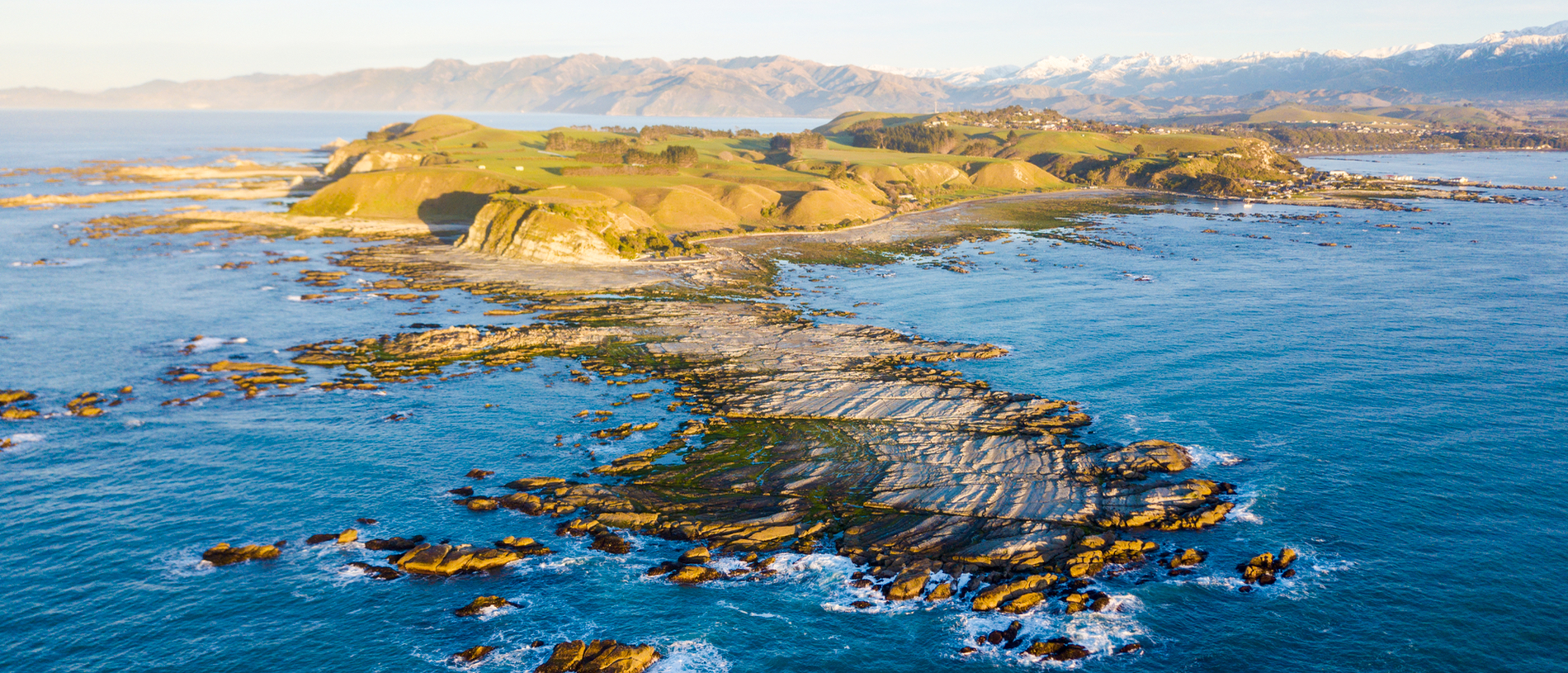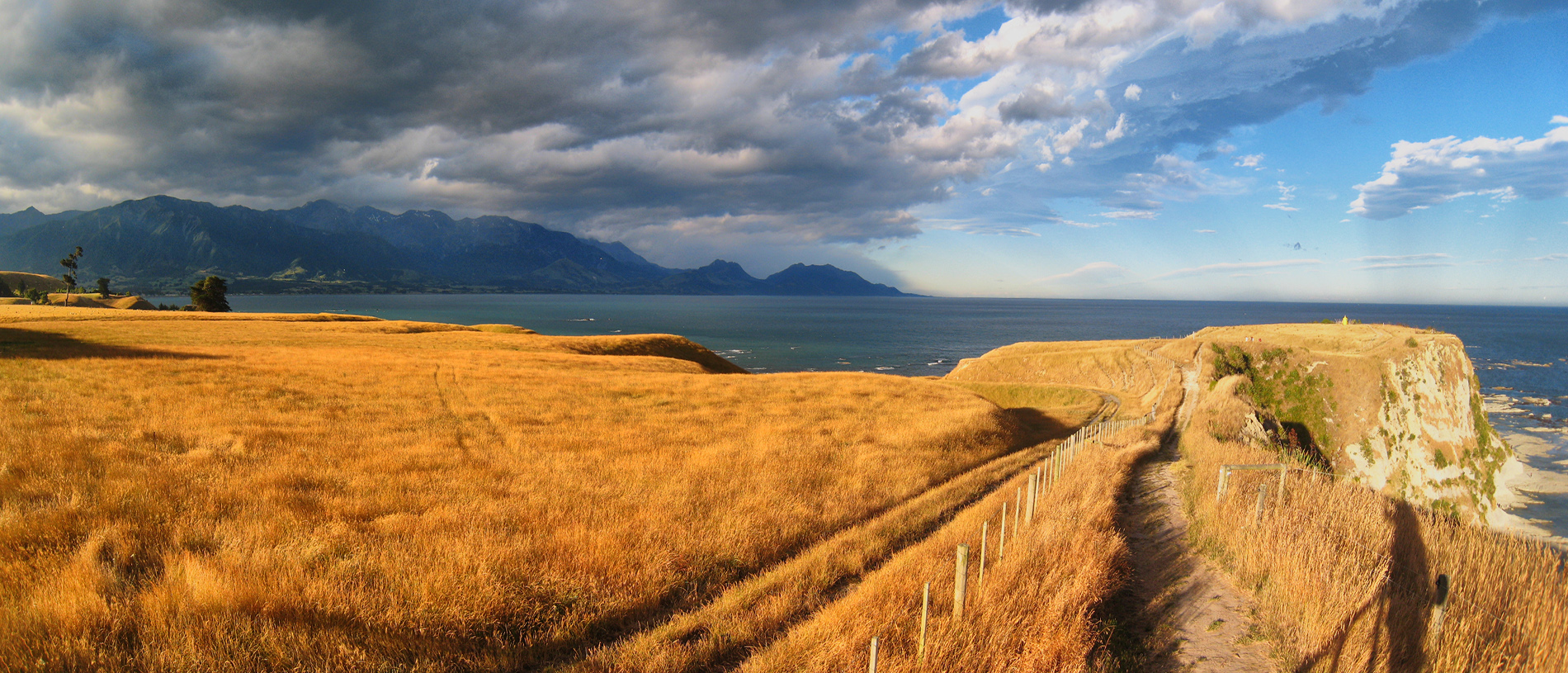
Coastal Kaikōura: magnificent marine life
Dozens of whale species are represented in these waters: most about as close to whale-watching tourists as they can get without actually hitting the beach.

Observe seals and seabirds, explore historic pā and whaling sites and enjoy sensational clifftop views of the sea and mountains from this unique walking track.
It’s suitable for families, too. The whole walkway takes about three hours but you can also explore a range of shorter tracks. There’s an impressive backdrop of steep mountains, snow-capped in winter, and wildlife in the area includes whales, dolphins, seals, birds and crayfish.
An impressive collection of information panels along the walkway explains the rich history, geology, animals and plants that make the area so special.
The track crosses the peninsula’s clifftop, with excellent views of the Seaward Kaikōura Range, ocean, and coastline, to South Bay.
It returns to the township via South Bay and Toms Track. The walkway starts from Kaikōura township. Distinctive marker posts and, at some locations, interpretation signs link a loop walkway, from West End in the town’s centre to Point Kean car park.
From the town centre, follow the footpath and road verge along The Esplanade, Avoca Street and Fyffe Quay to Point Kean. On the way, look out for the interpretation signs on The Esplanade opposite Brighton and Margate streets, telling stories of 'Life on the edge', a community living by the sea – the land, the sea and the people.
At Avoca Street, the sign takes you back to 1909, when the new wharf was built. Near Fyffe House, a sign details the early European settlement in Kaikōura and, at nearby Armers Beach, the story tells of the importance this site holds for the local community, both past and present, for the shelter it provides.
Near Point Kean car park, there are signs warning that seals are likely to be present in the surrounding area. Most of the seals in the car park are males. They may appear to be harmless – however, they are capable of becoming aggressive if disturbed and can inflict a nasty, infectious bite.
The seals on the rocky platforms out from the car park are females and their pups. For your safety and to avoid disturbing the seals, remain 10m from any seal in the vicinity of the car park. Along the rest of the Kaikōura Coast, 20m is the recommended distance to keep away from a seal.
Walk up the hill from the car park to a lookout platform. This platform, designed in the shape of a waka, affords an excellent view of both the sea and the mountains. Interpretation panels provide stories of the land, the sea and the people who lived here.
From the car park when the tide is low, you are able to explore the open tidal platforms. You may see wading birds, such as oystercatchers and reef herons, feeding on the platforms. Shags are common and blue penguins may be seen bobbing just offshore.
Just off the tidal platforms is an excellent diving and snorkelling area for those who want a closer look at the marine life.
Beyond the lookout platform, follow the track along the clifftop for superb views of rugged cliff formations, tidal platforms and the Seaward Kaikōura Range.
An interpretation panel on this section of the walkway explains that hundreds of years ago, the peninsula was forested with many species of native New Zealand trees and plants. Most of this vegetation was removed during successive waves of human development, leaving small, remnant outcrops of hardy shrubs and plants clinging to the steep cliff faces.
This track down a stairway follows a former whalers’ route down the cliff to the shoreline. A prominent feature in this area is known as 'the Sugarloaf'. Don't climb this landmark, to prevent further erosion.
View seabirds, seals, walkers, divers, crayfish floats, and fishing boats. Out to sea, you may see scores of seabirds feeding frantically on small fish herded to the surface by bigger fish or dolphins.
Take care to avoid disturbing any wildlife along the shoreline as there are large colonies of birds in the area. These are particularly vulnerable to disturbance during the breeding season over summer.
Return back up via the same cliff track, as tides or seals along the shoreline may prevent you from returning to the car park.
Interpretation on the clifftop overlooking 'the Sugarloaf' describes the point below as 'Bird City' – the largest red-billed gull colony in the South Island. From here, whalers kept a vigil over the sea, looking out for their quarry. Around the corner in Whalers Bay was the launching point for the whalers’ boats.
On the sea cliffs near this section of the walkway is a new colony of Hutton’s shearwater behind a large predator-proof fence. In summer you may see large rafts of these birds sitting on the water. At nightfall, after feeding at sea all day, they return to their breeding colonies high up in the Seaward Kaikōura Ranges. An interpretation panel explains the work being undertaken to establish a colony on the Kaikōura Peninsula.
From the South Bay viewpoint, the walkway descends to a fully accessible path that leads to an information shelter and toilets at South Bay. Before descending to South Bay, linger to view the tidal platforms and the view south. The interpretation panel here has a landscape profile identifying the mountain peaks and Goose Bay.
From the South Bay shelter, return to Kaikōura town centre by following the marker posts along the coast towards the marina. Follow the marker posts to South Bay Parade and cross to South Bay Track, walk up the hill, cross Scarborough Street and walk down Toms Track to return to The Esplanade.